Questions with Answers, Solution | Geometry | Term 2 Chapter 4 | 7th Maths - Exercise 4.3 | 7th Maths : Term 2 Unit 4 : Geometry
Chapter: 7th Maths : Term 2 Unit 4 : Geometry
Exercise 4.3
Exercise
4.3
Miscellaneous
Practice problems
1. In an isosceles triangle one angle
is 76°. If the other two angles are equal find them.
Solution:
In an isosceles triangle one angle = 76°
Sum of three angles = 180°
The other two equal angles = 180° – 76°
= 104°
One angle = 104/2 = 52°
The other two equal angles are 52°, 52°.
2. If two angles of a triangle are 46°
each, how can you classify the triangle?
Solution:
If two angles are equal
Corresponding two sides also equal. So it is an isosceles triangle.
3. If one angle of a triangle is equal
to the sum of the other two angles, find the type of the triangle.
Solution:
One angle = Sum of two angles
90° = 45°+ 45°
So, the triangle is the right angled triangle.
4. If the exterior angle of a triangle
is 140° and its interior opposite angles are equal, find all the interior angles
of the triangle.
Solution:
The exterior angle of a triangle = 140°
The exterior angle = Sum of two interior opposite angles. The
interior opposite angles are equal.
The sum of two interior oppositeangles = 140°
One angle = 140 / 2 = 70o
Third angle = 180° – 140° = 40°
The three angles = 70°, 70°, 40°
5. In ∆JKL, if ∠J = 60° and ∠ K = 40°, then find the value of exterior angle formed by extending the side KL.
Solution:
The exterior angle = Sum of two interior opposite angles.
The exterior angle ∠L = 60° + 40° = 100°
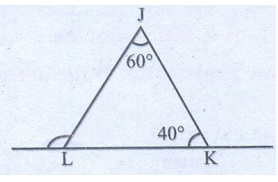
6.
Find the value of ‘x’ in the given figure.
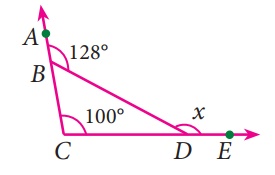
Solution:
The exterior angle ∠ABD = 128°
The exterior angle = Sum of two interior opposite angles.
128° = ∠BCD + ∠BDC
100° + ∠BDC = 128°
∠BDC = 128° – 100° = 28°
The inner angle ∠BDC = 28°
∠BDC + x = 180° (Linear angles)
28° + x =180°
x = 180° – 28° = 152°
x = 152°
7. If ∆MNO ≡ ∆ DEF, ∠ M = 60° and ∠ E = 45° then find the value of ∠ O.
Solution:
∆MN0 ≅ ∆DEF
∠M = ∠D, ∠N = ∠E, ∠O = ∠F
∠E = 45°
∠N = 45°
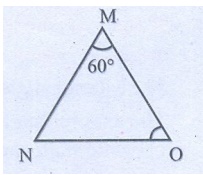
Sum of three angles of a triangle = 180°
∠M + ∠N + ∠O = 180°
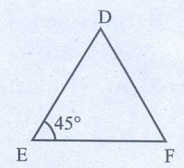
60° + 45°+ ∠O = 180°
105° + ∠O = 180°
∠O = 180° – 105° = 75°
∠O = 75°
8.
In the given figure ray AZ bisects ∠ BAD
and ∠ DCB,
prove that (i) ∆BAC ≡ ∆DAC (ii) AB = AD.
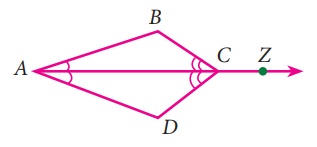
Solution:
From the given figure,
In ∆ BAC and ∆ DAC,
The ray AZ is the angle bisector of ∠A and ∠C
∴ ∠BAC = ∠DAC
∠BCA = ∠DCA
AC is common By
ASA criterion
∆ BAC ≅ ∆ DAC
∆BAC and ∆ DAC are congruent triangles, then their corresponding
parts are congruent. ∴ AB = AD.
9.
In the given figure FG = FI and H is midpoint of GI,
prove that ∆FGH ≡ ∆FHI
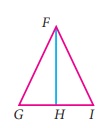
Solution:
From the figure, In ∆FGH and ∆FHI,
H is the mid point of GI.
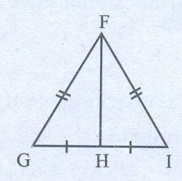
So, GH = HI
FG = FI (Given)
FH is common
By SSS criterion, ∆FGH ≅ ∆FHI
10.
Using the given figure, prove that the triangles are congruent. Can you conclude
that AC is parallel to DE.
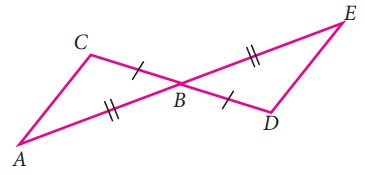
Solution:
From the figure, In ∆ ABC and ∆ BDE,
AB = BE
BC = BD
∠ABC = ∠DBE (Vertically opposite angles)
By SAS criterion,
∆ABC ≅ ∆BDE
So, AC = DE and AC | | DE
Challenge
Problems
11.
In given figure BD = BC, find the value of
x.
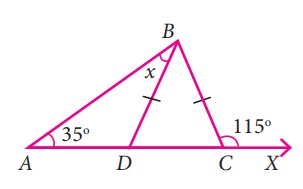
Solution:
In ∆ ABC, Exterior angle ∠C = 115°
∠BCD + 115° = 180° (Linear angles)
∠BCD = 180°–115° = 65°
BD = BC (Given)
So, ∠BCD = ∠BDC
∠BCD = 65°
So, ∠BDC = 65°
The exterior angle of ∠BAD is ∆BDC.
The exterior angle ∠BDC = The sum of two interior
opposite angles.
65° = 35° + x
x = 65°– 35° = 30°
12.
In the given figure find the value of x.
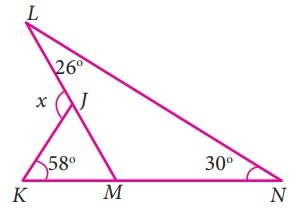
Solution:
From the figure,
The exterior angle of ∆LMN is ∠KML.
So the exterior angle ∠KML = Sum of two interior opposite
angles.
= ∠MLN + ∠MNL
= 26° + 30° = 56°
The exterior angle of ∆KMJ is ∠KJL.
So, the exterior angle ∠KJL = Sum of two interior opposite
angles,
x = ∠JKM + ∠KMJ
= 58° + 56° = 114°
x = 114°
13.
In the given figure find the values of x
and y.
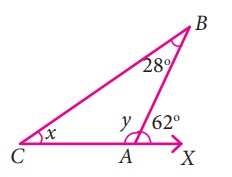
Solution:
From the figure,
The exterior angle ∠BAX = Sum of two interior opposite
angles.
62°. = ∠ABC + ∠ACB
62° = 28° + x
x = 62° – 28 = 34o
x = 34°
∠CAB + ∠BAX = 180° (Linear angles)
y + 62° = 180°
y = 180°– 62° = 118°
y = 118°
x = 34°
y = 118°
14.
In ∆DEF, ∠F = 48°,
∠E = 68° and bisector of ∠D meets FE at G. Find ∠FGD.
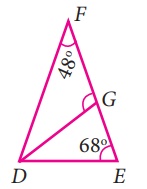
Solution:
From the figure,
In ∆DEF,
∠D + ∠E + ∠F = 180° (Sum of three angles
of a triangle)
∠D + 68° + 48° = 180°
∠D +116° = 180°
∠D = 180° – 116° = 64°
Angle bisector of ∠D is DG,
So, ∠FDG = ∠EDG ………… (1)
∠FDG + ∠EDG = 64°
From equation ………. (1)
∠EDG + ∠EDG = 64°
2 ∠EDG = 64°
∠EDG = 32°
The exterior angle ∠FGD = Sum of two interior opposite
angles.
= ∠DEG + ∠EDG
∠FGD = 68° + 32° = 100°
∠FGD = 100°
15.
In the figure find the value of x.
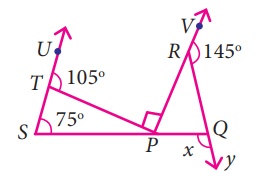
Solution:
From the figure,
The exterior angle ∠UTP = Sum of two interior opposite
angles.
105° = ∠TSP + ∠TPS
105° = 75° + ∠TPS
∠TPS = 105° – 75° = 30°
∠TPS + ∠TPR + ∠RPQ = 180° (Linear angles)
30° + 90° + ∠RPQ = 180°
120° + ∠RPQ = 180°
∠RPQ =180° – 120° = 60°
∠RPQ = 60o
∠VRQ + ∠QRP = 180o (Linear
angles)
145o + ∠QRP = 180°
∠QRP = 180 – 145° = 35°
The exterior angle ∠PQY = Sum of two interior opposite
angles.
∠QRP + ∠RPQ
x = 60o + 35o = 95°
x = 95°
16.
From the given figure find the value of y
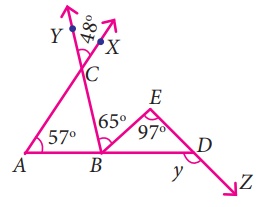
Solution:
From the figure,
∠YCX =48°
∠YCX = ∠ACB (Vertically opposite angles)
∴ ∠ACB = 48°
The exterior angle ∠CBD = Sum of two interior opposite
angles.
= ∠BAC + ∠ACB = 57° + 48° = 105°
∠CBD = ∠CBE + ∠EBD
105° = 65° + ∠EBD
∠EBD = 105° – 65° = 40°
The exterior angle ∠BDZ = The two interior opposite
angles.
∠BED + ∠EBD
y = 97° + 40° = 137°
y = 137°
ANSWERS:
Exercise 4.3
1. 52°, 52°
2. Isoceles triangle
3. Right angled
triangle
4. 40°, 70°, 70°
5. 100°
6. 152°
7. ∠O = 75º
10. (SAS), ∆CAB ≅ ∆EBD ; AC || DE
Challenge problems
11. x = 30º
12. x =
114º
13. x = 34º; y = 118º
14. 100°
15. 95°
16. y = 137º
Related Topics